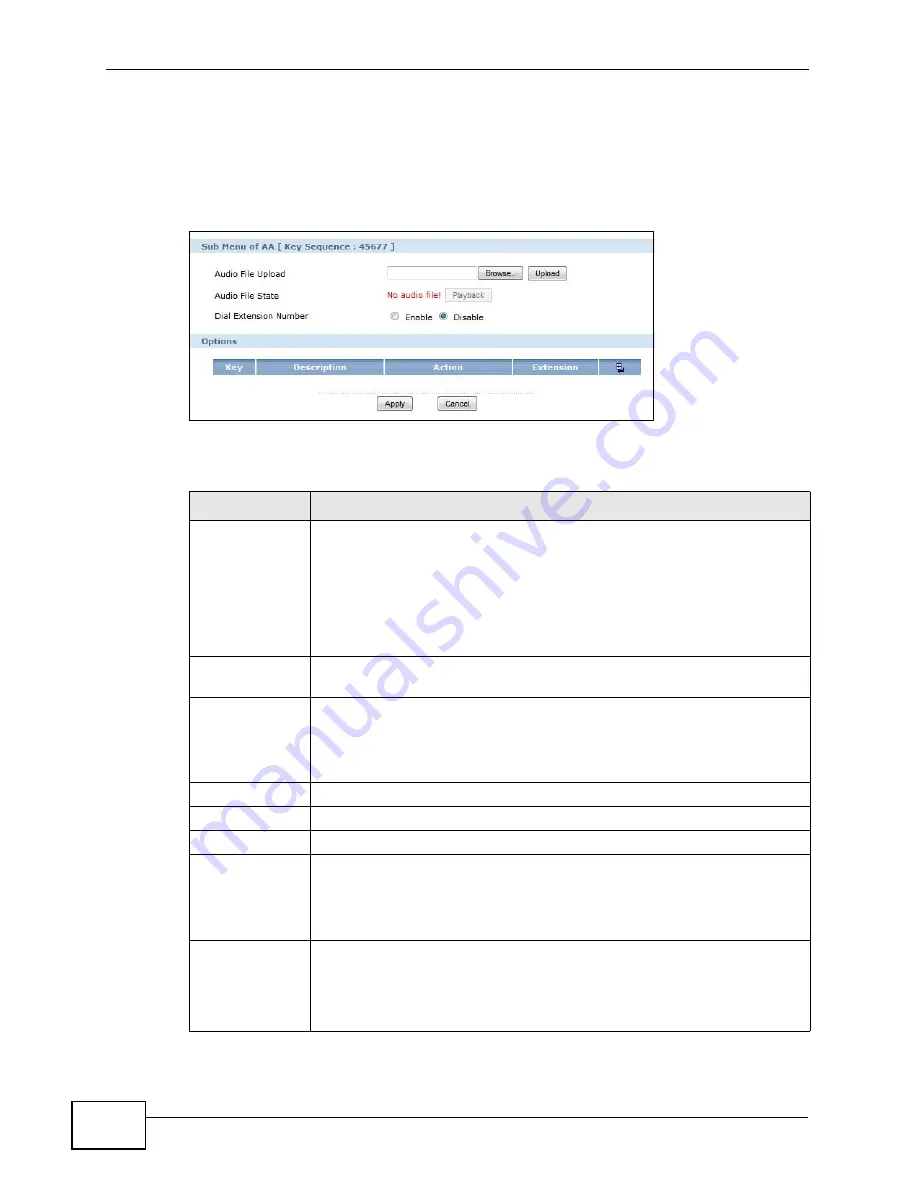
Chapter 19 Auto-Attendant
X2002 User’s Guide
296
19.3.4 The Auto-Attendant Sub Menu Screen
Use this screen to configure an option for an auto-attendant sub menu. To access
this screen, click the
Next Menu
button for an item in the auto-attendant list.
Figure 170
Auto-Attendant Sub Menu
Each field is described in the following table.
Table 105
Auto-Attendant Sub Menu
LABEL
DESCRIPTION
Audio File
Upload
Click
Browse
to locate an audio file to be used as the auto-attendant
greeting message, and
Upload
to copy it to IP-PBX.
The audio file you upload must meet the following criteria:
• G.711 format voice file (*.wav), µ-law 8-bit mono mode.
• Size limit of a single announcement cannot exceed 1 MB.
• Size limit of all voice files is 10 Mb per X2002 (or per ZyStack).
Audio File
State
This indicates whether an audio file has been uploaded to the X2002 or
not. You can also
Playback
the audio file to hear how it sounds.
Dial
Extension
Number
Select
Enable
if you want to allow incoming calls to dial extensions that
are not associated with specific key codes on the
Options
list below.
Select
Disable
if you want to limit all input to the key codes listed on
the
Options
table below.
Key
This field displays the digits a caller must dial to perform an action.
Description
This field displays the description for this action.
Action
This field displays the function of an action.
Extension
This field displays either the extension, hunting group or ACD number
that this call is forwarded to or it displays
Next Menu,
if the action for
this auto-attendant option is set to
Forward to a sub menu
.
Click
Next Menu
to configure the settings for a sub menu.
Add/Edit/
Delete
Click:
•
Add
to create a new option for this auto-attendant menu.
•
Edit
to change the settings for an auto-attendant option.
•
Delete
to remove this option from this menu.
Summary of Contents for X2002
Page 2: ......
Page 24: ...Table of Contents X2002 User s Guide 24...
Page 25: ...25 PART I User s Guide...
Page 26: ...26...
Page 40: ...Chapter 2 How It Works X2002 User s Guide 40...
Page 99: ...99 PART II Technical Reference...
Page 100: ...100...
Page 124: ...Chapter 5 Network Deployment X2002 User s Guide 124...
Page 166: ...Chapter 7 Auto Provision X2002 User s Guide 166...
Page 170: ...Chapter 8 QoS X2002 User s Guide 170...
Page 248: ...Chapter 16 Click To Talk Group X2002 User s Guide 248...
Page 252: ...Chapter 17 Group Access Code X2002 User s Guide 252...
Page 304: ...Chapter 19 Auto Attendant X2002 User s Guide 304...
Page 312: ...Chapter 20 LCR X2002 User s Guide 312...
Page 346: ...Chapter 22 Call Services X2002 User s Guide 346...
Page 380: ...Chapter 25 Status Observation X2002 User s Guide 380...
Page 402: ...Chapter 27 Call Detail Record CDR X2002 User s Guide 402...
Page 410: ...Chapter 28 ACD Logs X2002 User s Guide 410...
Page 416: ...Chapter 29 Administrator Accounts X2002 User s Guide 416...
Page 424: ...Chapter 30 Diagnostics X2002 User s Guide 424...
Page 426: ...Chapter 31 X2002 User s Guide 426...
Page 446: ...Chapter 32 Remote Management X2002 User s Guide 446...
Page 448: ...Chapter 33 TFTP Management X2002 User s Guide 448...
Page 462: ...Chapter 35 License Control X2002 User s Guide 462...
Page 482: ...Chapter 36 Web Portal X2002 User s Guide 482...
Page 508: ...Chapter 39 Product Specifications X2002 User s Guide 508...
Page 548: ...Appendix C Legal Information X2002 User s Guide 548...
Page 562: ...Index X2002 User s Guide 562...






























